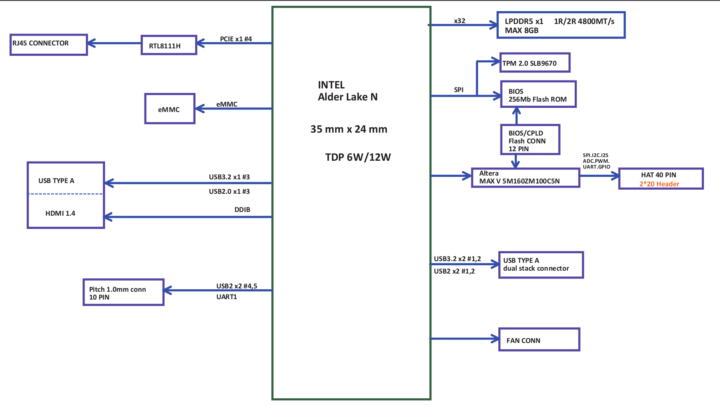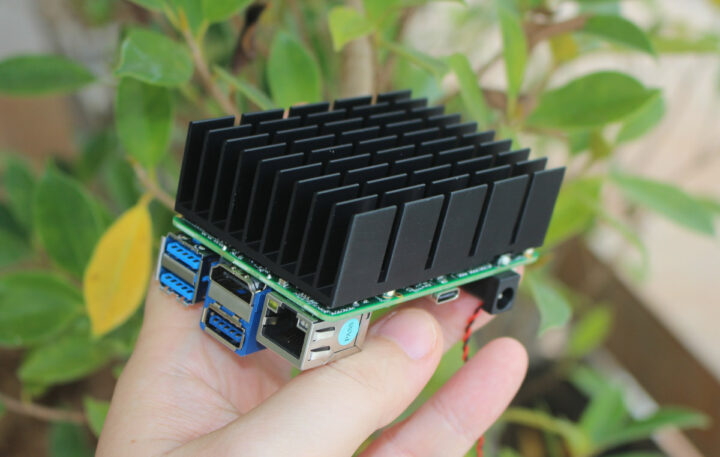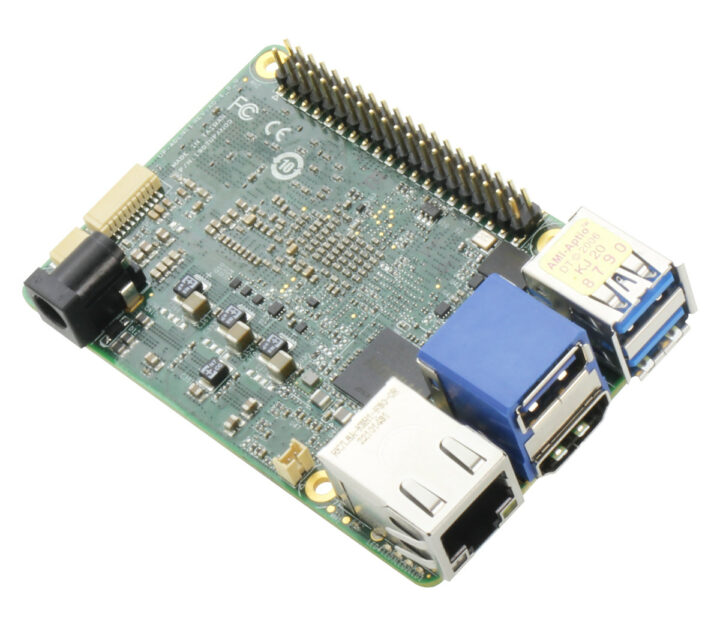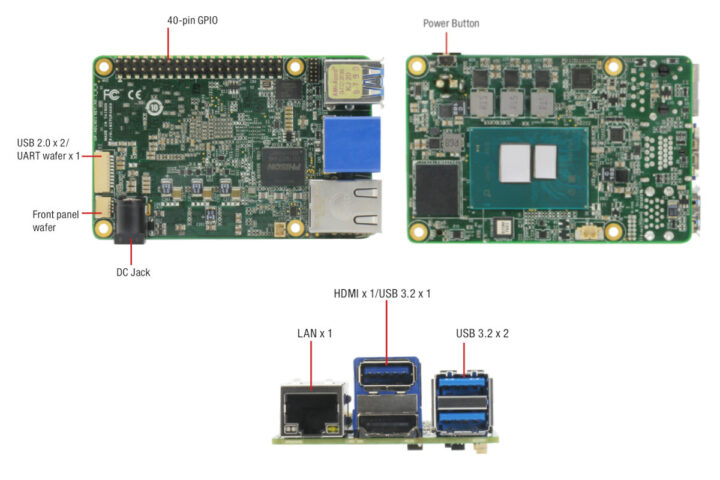AAEON UP 7000 is an x86 single board computer with a layout similar to the Raspberry Pi 4 but based on a more powerful Intel Processor N50, N97, or N100 Alder Lake-N SoC with Gigabit Ethernet, three USB 3.2 Gen 2 ports, HDMI 1.4 video output, and a 40-pin GPIO header.
Not to be confused with the larger UP Squared Pro 7000 also powered by an Alder Lake-N processor, the UP 7000 is an update to the UP 4000 SBC with an Intel Apollo Lake processor introduced just last year. The new fanless board also comes with up to 8GB LPDDR5, 64GB eMMC flash, and an onboard TPM 2.0.
UP 7000 (SKU: UP-ADLN01) specifications:
- Alder Lake-N SoC
- Intel Processor N50 dual-core processor up to 3.4 GHz with 6MB cache, 16EU Intel UHD Graphics Gen 12 @ 750 MHz; TDP: 6W
- Intel Processor N97 quad-core processor up to 3.6 GHz with 6MB cache, 24EU Intel UHD Graphics Gen 12 @ 1.2 GHz; TDP: 12W
- Intel Processor N100 quad-core processor up to 3.4 GHz (Turbo) with 6MB cache, 24EU Intel HD graphics @ 750 MHz; TDP: 6W
- System Memory – Up to 8GB LPDDR5
- Storage – Up to 64GB eMMC flash; 256Mbit flash for the BIOS/UEFI
- Video Output – HDMI 1.4b video output up to 4Kp30
- Networking – Gigabit Ethernet RJ45 port via Realtek RTL8111H-CG controller
- USB
- 3x USB 3.2 Gen 2 Type-A ports
- 2x USB 2.0 on 10-pin header (See expansion)
- Expansion
- 40-pin Raspberry Pi-compatible GPIO header via Altera Max V FPGA
- 10-pin header with 2x USB 2.0, 1x UART
- Security – Onboard TPM 2.0
- Misc
- 2-pin fan wafer (12V)
- RTC and 2-pin RTC battery wafer
- 4-pin front panel connector
- Power Supply – 12V DC-in, up to 5A; Type: AT (default) /ATX
- Power Consumption (Typical) – 30 to 36W
- Dimensions – 85 x 56mm
- Weight – 150 grams
- Temperature Range – 0°C ~ 60°C with 0.5m/s airflow
- Humidity – 0% ~ 90% relative humidity, non-condensing
- MTBF – 685,218 Hours
- Certifications – CE/FCC Class A, RoHS Compliant, REACH
- Longevity – Until year 2038

AAEON provides support for Windows 10 IoT Enterprise LTSC 2021, Ubuntu 22.04 LTS with Linux 5.15, and Yocto 4.0 for the UP 7000. A datasheet and user manual can be found on the product page, and eventually, the up-community website will have a wiki with detailed instructions.
I reviewed the UP 4000 SBC with Ubuntu 22.04 last year, and I was really happy with the board with everything working well out of the box. The performance was much better than on the Raspberry Pi 4 for most benchmarks, but not quite to the level of the DFI GH51 credit-card-sized board based on an AMD Ryzen Embedded R1606 processor. So I wish there was an option to get a more modern and faster Intel processor, and the UP 7000 SBC with an Intel Processor Alder Lake-N SoC should deliver on that front.

This is all great, but the Raspberry Pi 4 Alder Lake-N alternative will only be suitable for applications that require more performance and can tolerate a higher price tag since the UP 7000 starts at $189 with an Intel Processor N50, 4GB RAM, and 32GB eMMC flash, while the variant with a Processor N100, 4GB RAM, and 32GB flash goes for $199. Note those are pre-orders with shipping expected in October, and the other models are not for sale just yet. You may also consider adding the $12.99 power supply to your (pre-)order.

Jean-Luc started CNX Software in 2010 as a part-time endeavor, before quitting his job as a software engineering manager, and starting to write daily news, and reviews full time later in 2011.
Support CNX Software! Donate via cryptocurrencies, become a Patron on Patreon, or purchase goods on Amazon or Aliexpress







Alright, what’s the catch? N97 seems to have higher boost clock and GPU clock, other specs being almost identical. Is it just the TDP limit?
> Is it just the TDP limit?
Which is hard to compare since the 6W TDP for the N100 apply to a ‘Base Frequency’ of laughable 800 MHz while the 12W listed for the N97 apply to 2000 MHz.
With these weird Base Frequencies it’s really hard to get a clue how both CPUs perform at boost clocks (thermal and power limits) and at which consumption level. Would be a great opportunity for AAEON to test this stuff…
How they perform away from any base specification is going to be a matter of the silicon lottery. You can’t even expect a review to measure it and have that value be representative of anything but the review sample.
It runs the graphics faster, and maybe a few GHz on the cpu, at the cost of twice the TDP. You can’t believe these tdps, but it suggests Intel knows it’s going to run hotter.
The lower n## suggests Intel feels it’s lower than the n100 in the lineup, which makes the higher graphics an oddity. I’ve speculated a binning strategy in the past, but I have zero idea, and others feel not.
https://liliputing.com/intel-introduces-alder-lake-n-series-chips-for-laptops-priced-below-400/
on paper, I really don’t see the benefit over the n100…for me..
The n95 is especially weird
The n50 is more like for embedded low power uses.
How is the Max V connected to the rest of the system?
Do they provide drivers fo it? Seeing that it’s a custom I/O expander solution.
Funnily enough, x86 SoCs do have SPI, a couple of GPIO and stuff, it’s just not generally avaliable to user mode and made to just connect it to motherboard peripherals.
https://github.com/up-board/up-community/wiki/40Pin-Header
Yes, but the GPIO on the x86 SoCs doesn’t run at the typical 3.3V level that these Raspberry-likes use, but instead at 1.8V or lower. I don’t know about these specific SoCs, but I seem to recall having read somewhere that the newer SoCs use 1.2V or even 0.8V, so you wouldn’t be able to use most typical sensors and stuff directly.
I think the FPGA makes GPIO usage “transparent” on the UP 7000.
When I checked the GPIO function on the UP 4000, the GPIOs were listed as on any other boards with sysfs.
@jean-luc, what’s up with the “Alder Lake-N” confusion in the table. The table is listed as Alder Lake-N but the N100 has it explicitly listed again in the product listing. They’re all Alder Lake-N chips, no? Intel’s ARK seems to think so.
It’s sort of funny to see the broad range of the offerings in this product. They vary from as low as $189 all the way up to $199. Memory ranges from 4GB to 4GB and storage from 32GB all the way up to 32GB! There’s a board for every use!
I won’t touch a board like this without M.2 2280 with four lanes of PCI-E. eMMC doesn’t cut it.
Sorry for the confusion. I copied the N100 line from another post and forgot to remove the “Alder Lake-N” in the line.
Thank you for the correction. Some of us are more spatial/visual and read those three lines in parallel so the difference really stood out. Like the “(turbo)” does now.
HDMI 1.4b? No thanks. And eMMC just doesn’t cut it either when you consider the pricing.
This seems little more than a Mini PC board with additional GPIO, which doesn’t seem to that desirable.
I think the RPi form factor and size are overrated. Constrains what can be put on the board.
“Form Factor” if you ignore the huge heatsink off the bottom.
If you don’t need the GPIO, you can search aliexpress for N100 Mini-PC. Like this one with specs N100, 16GB DDR5, 256 SSD, 2xGb Lan, 3xHDMI, 3xUSB3.1 for $168.: https://www.aliexpress.com/item/1005005076549630.html
Cheap complete system. With just 1 minuses: don’t expect BIOS update.
I am looking on SOC and it has two parts
1.probably CPU
2.probably GPU
I saw old Intel 5000 line and it was one piece of silicon. And really small one
So they added AVX and now it is that huge?
Yeah, Intel calls this a SoC, but it’s two chips, so it’s clearly a SoM. Also, that’s a ton of silicon for what it does.
It’s documented: CPU + PCH made on different process nodes: https://edc.intel.com/content/www/us/en/design/ipla/software-development-platforms/servers/platforms/intel-pentium-silver-and-intel-celeron-processors-datasheet-volume-1-of-2/005/block-diagram/
It is a pity there is no SATA or NVME connector for cheap SSD.
This is close. Hopefully soon they’ll be a x86 SBC that is fast enough to be useful, with enough of the right kind of interfaces, for a price that I can justify paying.
If this one had a SATA channel or two, and a PCIE 4x and/or a couple of 1x lanes I’d be there. If this thing was $139-$159 I’d probably be preordering now instead of bellyaching here with you fine folks.
The UP 7000 is also sold as the AAEON Nezha but with a red PCB and N97 CPU only.
It looks to be for the mainland China market, but Youyeetoo also sells the SBC: https://www.youyeetoo.com/products/nezha-developer-kit?VariantsId=11731
So, more expensive than a Radxa X4 that goes to 16GB memory and 128GB flash (and is still cheaper than Up’s base price) and has an NVMe slot. And a 2.5G Ethernet and wifi+BT.